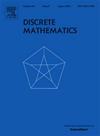Conformality of minimal transversals of maximal cliques
IF 0.7
3区 数学
Q2 MATHEMATICS
引用次数: 0
Abstract
Given a hypergraph , the dual hypergraph of is the hypergraph of all minimal transversals of . A hypergraph is conformal if it is the family of maximal cliques of a graph. In a recent work, Boros, Gurvich, Milanič, and Uno (Journal of Graph Theory, 2025) studied conformality of dual hypergraphs and proved several results related to this property, leading in particular to a polynomial-time algorithm for recognizing graphs in which, for any fixed k, all minimal transversals of maximal cliques have size at most k. In this follow-up work, we provide a novel aspect to the study of graph clique transversals, by considering the dual conformality property from the perspective of graphs. More precisely, we study graphs for which the family of minimal transversals of maximal cliques is conformal. Such graphs are called clique dually conformal (CDC for short). It turns out that the class of CDC graphs is a rich generalization of the class of -free graphs. As our main results, we completely characterize CDC graphs within the families of triangle-free graphs and split graphs. Both characterizations lead to polynomial-time recognition algorithms. Generalizing the fact that every -free graph is CDC, we also show that the class of CDC graphs is closed under substitution, in the strong sense that substituting a graph H for a vertex of a graph G results in a CDC graph if and only if both G and H are CDC.
最大团的最小截线的共形性
给定一个超图H, H的对偶超图是H的所有最小截线的超图。如果超图是图的极大团族,那么它就是保角超图。在最近的一项工作中,Boros, Gurvich, milaninik和Uno (Journal of Graph Theory, 2025)研究了对偶超图的共形性,并证明了与该性质相关的几个结果,特别是导致了一个多项式时间算法,用于识别图,其中对于任意固定k,最大团的所有最小截线的大小最多为k。在后续工作中,我们为图团截线的研究提供了一个新的方面。从图的角度考虑对偶共形性。更确切地说,我们研究了极大团的最小截线族是共形的图。这样的图被称为团对偶共形(简称CDC)。结果表明,CDC图类是P4-free图类的丰富推广。作为我们的主要结果,我们在无三角图和分裂图族中完全表征了CDC图。这两种特征都导致了多项式时间识别算法。推广了所有无p4图都是CDC的事实,我们还证明了CDC图类在替换下是封闭的,即当且仅当G和H都是CDC时,用图H替换图G的顶点得到一个CDC图。
本文章由计算机程序翻译,如有差异,请以英文原文为准。
求助全文
约1分钟内获得全文
求助全文
来源期刊

Discrete Mathematics
数学-数学
CiteScore
1.50
自引率
12.50%
发文量
424
审稿时长
6 months
期刊介绍:
Discrete Mathematics provides a common forum for significant research in many areas of discrete mathematics and combinatorics. Among the fields covered by Discrete Mathematics are graph and hypergraph theory, enumeration, coding theory, block designs, the combinatorics of partially ordered sets, extremal set theory, matroid theory, algebraic combinatorics, discrete geometry, matrices, and discrete probability theory.
Items in the journal include research articles (Contributions or Notes, depending on length) and survey/expository articles (Perspectives). Efforts are made to process the submission of Notes (short articles) quickly. The Perspectives section features expository articles accessible to a broad audience that cast new light or present unifying points of view on well-known or insufficiently-known topics.
 求助内容:
求助内容: 应助结果提醒方式:
应助结果提醒方式:


